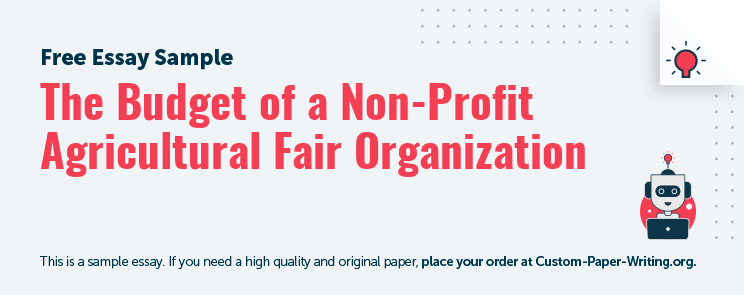
Introduction
Budgeting activities is a vital source of existence even of a non-profit organization. As an ultimate outcome of the budgeting process, a budget includes necessary sources and volumes of costs and income. Outsourcing sponsors and domestic resources usage are the ways to perform non-profit activities. The budget process for non-profit agricultural fair organizations should be based on their conceptual framework and guided by stated non-commercial goals. Even if an organization does not seek to obtain a commercial advantage, it still needs to allocate necessary financial resources properly.
Budget Importance
An agricultural non-profit fair organization is an entity directed by the goal to finance and manage particular periodic agricultural fairs. The latter do not only require farmers’ efforts, but also the organizational support of a non-profit entity. Therefore, the organization manages its financial capacity based on the budgeting processes. The preparation of a budget by a non-profit agricultural fair organization is a constituent part of strategic management, particular planning. The budget of such organization includes organizational expenses and obtained revenues as the main aspects of common budget composition. Budget preparation logically begins only after the determination of a mission and strategic goals. Participants at this stage are the board of directors that estimate the strengths and weaknesses of the organization, identify its complexities and opportunities, and forecast the perspectives for at least a year (“Budgeting for Non-Profit Organizations,” 2009).
Calculate the cost of essay
The organization may be also guided by a special committee responsible for financial issues and fund-raising. Therefore, the budget reflects important financial resources of the organization. The personnel may participate in budget development through the calculation of all expenses and financial resources in order to achieve stated goals. Personnel’s involvement is essential for budget formation due to the knowledge of funding resources and appropriate governmental programs.
The objectives maintained in annual working programs of agricultural fairs determine the quality and quantity of resource potential applied to meet goals. Lists of activities and measures planned during agricultural fairs influence the budgeting process directly, requiring fund allocation. In addition, the budget contains administrative and managerial costs and inputs of fund-raising. Thus, its preparation and introduction by the non-profit organization is not only a demonstration of the planned activities and consumed financial resources, but also a way to rally the efforts of the personnel and leaders of such organization.
Limited time Offer
with code
Budget for Business Management and Policy
Introduction
A budget serves as a tool to manage a business formulated pursuant to special policies. It expresses various policies of the company through financial terms and presents quality, quantity, and certain types of services in order to introduce the mission and goals of the agricultural fair organization.
The exploitation of the budget to manage activities of the non-profit organization is carried out through managerial functions. The budgeting process is included in the development of strategic and annual planning. Financial resources used by the organization to organize an agricultural fair influence further allocation of funds and opportunities of the organization. As the central component of any planning process, the budget estimates the efficiency of fund-raising and resource exploitation. Regular reports comparable to the annual budget identify the vulnerability and sustainability of strategic and ongoing processes. An accurate calculation of income and costs will result in a wider opportunity to introduce all expected changes.
Benefit from Our Service: Save 25% Along with the first order offer - 15% discount, you save extra 10% since we provide 300 words/page instead of 275 words/page
Different approaches to the budgeting process constitute a particular policy of the organization. In turn, budgeting and financial polices guide budget exploitation. For example, the Washington Sustainable Food & Farming Network, a non-profit organization, introduced a special policy dedicated to the support of sustainable practices in the agricultural sector, conducting a fair for farming entities to participate in it (Welcome, n.d.). These initiatives are reflected on the budget specifics. The annual budget of this organization is oriented at the support of the local authority, funds of the agricultural sector, sponsors, and the ultimate income of periodic fairs. Consequently, the way of budget distribution includes the promotion of agricultural fairs, local production of food, advertising campaign, implementation of education programs, involvement of volunteers, and other social activities aimed to draw attention to the necessity of farming sector promotion (Alameda County Agricultural Fair Association, 2015).
VIP services
Extended revision period $2.00
SMS notification of the order status $3.00
Get order proofread by editor $3.66
Get order prepared by top 30 writers $4.40
Get a full PDF plagiarism report $5.99
Get VIP support $9.99
VIP SERVICES PACKAGE WITH 20% DISCOUNT $23.23
The Alameda County Agricultural Fair Association in California introduced a policy of liability. Guided by the provisions of this specific policy dedicated to the care of the counties’ community and development of the farming sector, the Association includes a significant insurance in its budget covering personal injuries and damage of property. These costs are part of the common budget of the organization. Moreover, the compensation of workers and sponsorship agreements are emphasized in the budget of the Pleasanton’s Organization. Due to such strong social initiatives, the Association faced more expenses than revenues in 2013.
Conclusion
The budget of the non-profit agricultural fair organization determines all directions of its activity and manages their further effective implementation. The budgeting process includes necessary procedures of determining income sources and costs. Budget development should be performed through the participation of the whole personnel according to various functional obligations, experience in fund-raising, and applied knowledge to name a few. The non-profit organization intending to develop an accurate budget may use it as the main tool of financial and business management. Moreover, the budget enables the organization to use financial and other resources and introduce any socioeconomic policy. Particular non-profit organizations specify their budgets according to social policies influencing their performance within the farming sector.
- Share this post with your friends:

